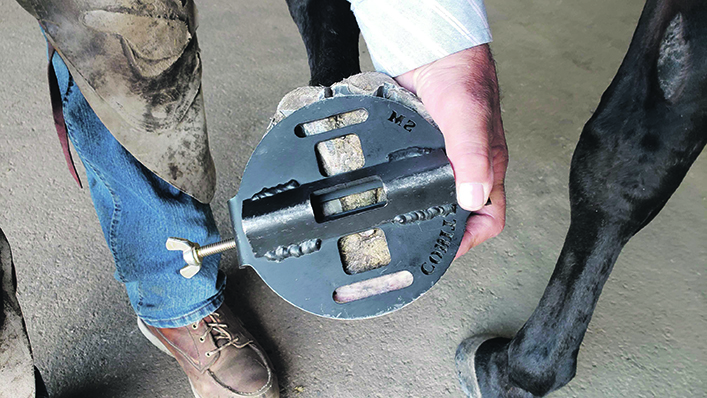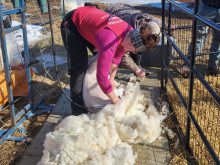A Sask. farrier finds that the key to successfully treating hoof problems is to give the horse an accurate centre of balance
A horse named Henry prompted Ross Smith to search for a better way to help all horses with foot problems.
Henry, now a 13-year-old Quarter horse gelding, had been suffering from severe lameness for almost two years. That was eight years ago.
After several veterinarians said they had done as much as they could for Henry, owner Angie Bigler of Regina decided to euthanize him.
“We were going to put him down. Actually, I came home one day and told my husband I was calling the neighbour to dig a hole because I just couldn’t see him suffer anymore,” said Bigler.
Smith, a professional farrier and inventor, was determined to find a solution for Henry’s problems.
“He had such severe lameness issues that all veterinarians that were looking after him finally said, ‘we can’t help him, you need to put Henry down, he’s just suffering too much’,” Smith recalled.
“Henry was to the point where he could no longer be ridden. He had trouble getting around even.”
Smith said he has shod almost every type of horse over the years, but his passion is working with horses that have lameness problems.
“That is the number one curse of the horse, especially in the competitive world. Lameness is when your horse will have a sore foot, sore leg, maybe sore back, whatever. And there’s an old saying that says no hoof, no horse.
“So I deal with the hoof part and what I’ve learned over my years of shoeing horses is the hoof is the foundation of the horse,” said Smith.
After convincing Bigler to let him work with Henry, Smith said he was determined to deliver a solution.
Years of working with lame horses and with veterinarians had taught him about common causes of lameness.
With the help of a local vet, Smith started with X-rays of Henry’s feet.
“As a result of X-raying horses for many years, I have come up with a distance, a common measurement from the centre of balance to where the front of the horse’s foot should be, which is just off the front of the coffin bone. That measurement is five centimetres for the average-sized Quarter horse’s foot,” he said.
In previous years, Smith had designed, patented and built a tool that indicates a horse’s centre of balance. He calls it the COBIT (Centre of Balance Indicating Tool).
Once the tool has identified the centre, “we shoe the horse so that we have equal amounts of foot on either side of the centre of balance. That greatly helps a horse with its soreness issues, not only in his feet but throughout the entire body,” said Smith.
The horse’s foot is placed on the COBIT. A side screw is put into the hoof wall to hold the foot in place. Then the opposite leg is picked up, which forces the horse to put its standing weight on the COBIT.
“If you have it in the correct place, it will balance. If you have it too far forward it tips forward, too far backwards it tips backwards. It’s basically a teeter totter… What we want to have when we’re done is equal amounts of weight on either side so it balances.
“Then you go to the back part and the horse should have an equal amount of a foot to the rear of centre of balance, so that’s how far back you trim the heel of the horse. So when you’re done, your horse is loading his foot (with) equal amounts of weight on either side,” he said.
The COBIT determines where to trim a hoof if the horse is barefoot.
Smith emphasizes the importance of trimming and shoeing to give the horse an accurate centre of balance.

“For every centimetre the foot is forward from that breakover mark, it adds 50 kilograms of torque to the tendons in the rear of the horse’s leg. As your horse’s foot grows forward, it greatly increases the pressure on the rear leg, which is the number one place where the horse goes lame or gets sore.
“Our job is to shoe the horse according to the horse’s bone structure, but we can’t see the bone structure because it has hoof over it, hide and hair and everything else. So if we don’t have access to a veterinarian to X-ray the horse’s foot to show us exactly where we need to be, what the COBIT does is tell you where the coffin bone is, and how to shoe the horse’s foot according to the coffin bone instead of what we see on the outside.”
Smith has sold about 200 COBITS in the past year and said the results have been life altering for many horses and owners.
“When we shoe a horse using this, the horse gets an instant relief, sometimes very dramatic to the point where I’ve had customers break out in tears, they’re so blown away by the change in their horse.”
So it was for Henry eight years ago.
“It took about a year before Henry was back being rode again. Since then, he’s won national titles and is still a competitive show horse to this day,” Smith said.
Bigler remains grateful.
“It’s just remarkable. We had hoped that we would get him to the point where I can just go out and ride and I never dreamed I’d be back in the show ring with him. And he’s out there giving it all. It’s amazing the change in him.”


















